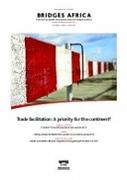Implementing the Trade Facilitation Agreement should boost trade among African Continental Free Trade Area members
12 février 2024

De Melo, J. and Wagner, L. (2016) "How the Trade Facilitation Agreement can help reduce trade costs for LDCs", Bridges Africa: Trade facilitation: A priority for the continent? , Vol. 17 (6), July 2016.